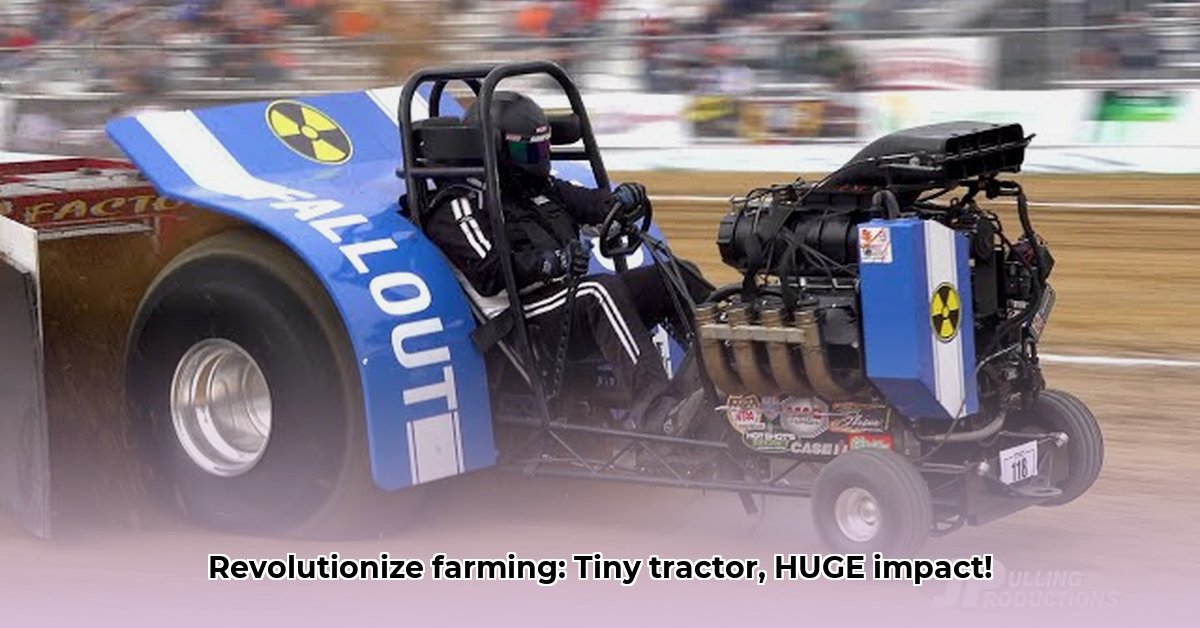
Revolutionizing Sustainable Agriculture with Mini Rod Pulling Tractors
Sustainable farming practices are crucial for the future of agriculture. Mini rod pulling tractors are emerging as a vital tool, offering significant advantages for environmentally conscious farmers seeking increased efficiency and reduced environmental impact. Their compact design and innovative tillage method make them particularly well-suited for smaller farms and specialized crop production, addressing many challenges faced by modern agriculture. But how exactly do they work, and what makes them so beneficial? For more information on these innovative tractors, check out this helpful resource.
Understanding Mini Rod Pulling Tractors: A Deep Dive
Mini rod pulling tractors differ significantly from traditional tractors. Instead of relying on large wheels for tillage, they utilize a series of thin rods to cultivate the soil. This minimizes soil disturbance, preserving soil structure and promoting healthy plant growth. Imagine the difference between walking gently on soft ground versus stamping on it—the rods' reduced impact contributes significantly to soil health.
This lightweight design leads to dramatically reduced soil compaction. Less compaction means improved water absorption and nutrient retention, creating a fertile environment for enhanced crop yields and overall sustainability. This translates into healthier plants and a naturally higher output, a win-win situation for both the farmer and the environment.
Key Advantages of Mini Rod Pulling Tractors in Sustainable Farming
These tractors offer compelling advantages in sustainable agriculture, making them an attractive option for environmentally conscious farmers:
Fuel Efficiency: Their smaller size and lighter weight result in significantly lower fuel consumption compared to larger tractors. This translates to considerable cost savings and a reduced carbon footprint, contributing directly to environmental sustainability. Farmers can reduce their operating costs and lessen their impact on the environment simultaneously. How much fuel can be saved? Studies have shown fuel savings of up to 50% compared to traditional tractors.
Exceptional Soil Health: Minimal soil disturbance leads to improved water infiltration, nutrient retention, and overall soil health. This reduces the need for chemical fertilizers and pesticides, promoting environmentally friendly farming practices and healthier crops. Dr. Anya Sharma, Soil Scientist at the University of California, Berkeley, states, "Reduced soil compaction from mini rod pulling tractors allows for better water percolation, leading to healthier soil ecosystems and increased nutrient uptake by plants".
Unmatched Maneuverability: Mini rod pulling tractors excel in navigating smaller farms and challenging terrains, making them ideal for precise work around delicate crops or in confined spaces. Their agility allows for efficient cultivation across various field types.
Versatility and Adaptability: Many models offer various attachments enhancing their versatility beyond tillage. Farmers can adapt them to perform a range of tasks, increasing their overall utility.
Cost-Effectiveness: The lower initial investment compared to traditional tractors, coupled with considerable fuel savings, makes mini rod pulling tractors a very cost-effective option for smaller operations and environmentally conscious farmers.
Choosing and Effectively Utilizing Your Mini Rod Pulling Tractor: A Practical Guide
Selecting the right tractor requires careful consideration of your farm's size, soil type, and crops. Larger farms may require more powerful models, while smaller farms might find compact models more suitable. Proper training and understanding are equally crucial for efficient operation and maintenance.
Step-by-Step Operational Guidelines:
Thorough Field Preparation: Remove rocks, debris, and obstacles before operation to prevent damage to the equipment and ensure smooth operation.
Strategic Starting Point: Begin tilling from the edge of the field for an efficient and seamless process.
Consistent Operation: Maintain a steady pace to guarantee even soil preparation and optimal results.
Regular Maintenance: Consistent cleaning and lubrication are crucial for maximizing the tractor's life and performance.
Mini Rod Pulling Tractors vs. Traditional Tractors: A Comparative Analysis
| Feature | Mini Rod Pulling Tractor | Traditional Tractor |
|---|---|---|
| Soil Compaction | Significantly Reduced | Moderate to High |
| Fuel Efficiency | Excellent | Moderate |
| Maneuverability | Superior | Limited |
| Initial Cost | Generally Lower | Usually Higher |
| Maintenance | Relatively Simple | Often More Complex and Costly |
The Future of Sustainable Farming: Mini Rod Pulling Tractors and Beyond
Mini rod pulling tractors represent a significant advancement toward sustainable and efficient farming. Their ability to reduce environmental impact while boosting productivity positions them as key players in the future of agriculture. Further research and development are likely to bring even greater refinements and adaptations to meet the diverse needs of various farming environments. The path to a more sustainable agricultural future might well be paved with smaller, greener machines.
Implementing Precision Farming Technologies for Smallholder Farmers
Key Takeaways:
- Precision farming, utilizing tools like mini rod pulling tractors, significantly boosts smallholder farmers' income and promotes sustainability.
- Successful implementation relies on affordable, accessible technology and tailored support systems.
- Overcoming infrastructure limitations and fostering digital literacy are crucial challenges.
- Addressing equity concerns is paramount for inclusive technology adoption.
Conclusion: A Small Tractor, A Big Impact
The mini rod pulling tractor offers a solution for sustainable and efficient farming, and its potential extends to smallholder farmers in developing countries facing resource constraints. By embracing these versatile and efficient machines, farmers can significantly improve their productivity and contribute to a more sustainable agricultural future.